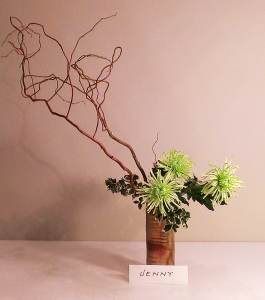 Ikebana, the art of Japanese flower arrangement, is now quite well-known in most parts of the world. I have been a student of ikebana, off and on for over a decade. At first, I decided to take lessons as a way to add a few flowers in our home. Flowers in the home always make me smile as they add color and life to the space. Over the years, I’ve found that learning ikebana had an unexpected benefit. Practicing this art form required a lot of mental and artistic creativity and was challenging yet very relaxing.
Ikebana, the art of Japanese flower arrangement, is now quite well-known in most parts of the world. I have been a student of ikebana, off and on for over a decade. At first, I decided to take lessons as a way to add a few flowers in our home. Flowers in the home always make me smile as they add color and life to the space. Over the years, I’ve found that learning ikebana had an unexpected benefit. Practicing this art form required a lot of mental and artistic creativity and was challenging yet very relaxing.
At first glance, Ikebana looks like just a random selection of a few flowers, leaves and branches in a vase. Many people nowadays often confuse ikebana with a zen approach to flowers, often calling it zen flowers. In reality, this is far from the truth. Placing a single leaf or flower in a vase can be a zen form of an arrangement but it’s not ikebana. The former requires no skill nor much thought. There is nothing wrong with this – infact, I love it and do it all the time. However, I do know this type of simple arrangement is not related to the philosophy behind the art of Ikebana.
To the beginner, ikebana may look fairly simple and easy. After all, it’s only a few flowers and branches placed in a vase – how difficult could that be right? However, once you attempt to do this yourself, you understand that it’s actually quite challenging. Putting together an arrangement does require much thought, skill, and technique. It begins with the search of materials, the appropriate vase, and even the setting.
Material:
The materials in ikebana are the flowers, branches, and other items used in your arrangement. In a traditional ikebana class in Japan, the teacher may provide all your materials for you. My girlfriend took classes in Tokyo and she said the teacher had all the flowers laid out with the vase ready. Their lesson was to ‘copy’ the teacher’s arrangement. Here in the Pacific Northwest, we are blessed with good weather and a variety of plants and vegetation. Unlike an urban city, our ‘material’ can be found almost anywhere. My teacher’s garden is her source for various plants that are suitable for ikebana. She just cuts flowers and branches from her yard – isn’t that just fabulous! Of course, flowers are seasonal, and we can’t grow everything so we do have to purchase flowers and branches as well. However, having the option of just going to the greenbelt in our neighborhood or taking a few branches from our back yard, makes material hunting fun and less stressful.
The other great lesson I received from ikebana, is that now I look at nature through a different perspective. A dead branch isn’t just a dead branch any longer. Previously, I would classify that as ‘dead’ which would equal ‘without life’ which meant ‘not useable’. However, now a dead branch is a ‘different form’, has interesting color and is a passage of life. I think to myself, ‘how can I use this piece in ikebana and give it a second life’. You see, only my perception has changed but it has taught me to appreciate nature in all her stages. Every stage now has beauty and use.
The other obvious thing that I never really appreciated is that in nature, no two branches are the same. That means, you really can’t reproduce the same arrangement again! Each and everyone is unique – I really like that.
Vase:
In Japanese, vase is kabin. In ikebana they use the term kaki. Choosing the correct vase is another aspect of ikebana. Through the observation of material form, color and texture, we learn to find a good match to enhance the arrangement. When you have large heavy branches, your vase must be able to hold up the weight. The other day I had huge branches and wanted to use a wide rectangular vase that was about six inches high. Unfortunately, no matter how hard I tried, I didn’t have the skill to create the form I wanted. It was too difficult and one of the reasons was because the branches were too think for that particular vase. There’s a lot of trial and error. Lesson learned!
Another aspect to consider is the color of the material you’re using. Complementing the color of the flowers with the vase can give you a whole new perspective of the arrangement and that’s what makes ikebana challenging and fun!
Environment:
Another consideration when creating an ikebana arrangement is the location where it will be displayed. How much space do you have? Will it be against a wall or in the middle of a table? This will change the various views. What color is the background? And the questions continue. There are so many things to consider.
As you can see, materials, vase, and environment have great influence on ikebana. Sometimes, the more you think about it the move confused you get. So, when starting we just have to begin from learning technique, then slowly expand from there.
We need to remember that all the living elements in a arrangement will change over time, so each moment is a moment to enjoy. That is the beauty of ikebana. All three elements; materials, vase and setting, must come together as one.
It’s rather amazing , to come to realize how a simple ikebana arrangement makes you stretch your creativity and requires a good amount of thought and preparation. I’ve found that for myself, this simple act of arranging flowers makes one forget about everything else in the world. It’s like a little get away session for a few hours that relaxes the mind. If you get a chance, why not try a class.
I take Sogetsu classes from Megumi Schacher. She’s absolutely fabulous. If you live in the Greater Seattle Area, come join us, it’s so much fun!



